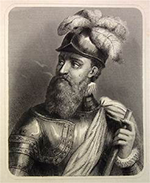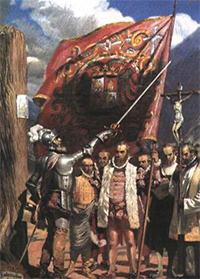Francisco Pizarro: Conqueror of the Inca
Francisco Pizarro was a Spanish conquistador most well-known for his conquest of the Inca Empire. 
He was born in the 1470s in Trujillo, in an area of Spain known as Extremadura. His father was Gonzalo Pizarro Rodríguez de Aguilar, poor farmer and soldier who had fought in wars in Italy. Francisco's mother, Francisca Gonzalez, was not Aguilar's wife and so the boy did not enjoy the privileges that his "legimitate" siblings did. Francisco became a soldier, like his father, and fought in Italy for a time before joining an expedition to the New World. He went in 1502 with Nicolás de Ovando, who served It was also in the name of great wealth that Pizarro formed an alliance with another conquistador named Diego de Almagro. Flush with anticipation at following in the footsteps of Hernán Cortés–who gained great wealth by conquering the Aztecs–the pair led two expeditions along the west coast of South America in the early 1520s; on that second voyage, they visited the city of Tumbes, part of the Inca Empire. Fueled by stories of great riches to be had at the Inca capital, Cuzco, the Spaniards vowed to return. Pizarro returned to Spain and pleaded with King Charles I to finance another expedition. The king agreed and gave Pizarro the right to claim governorship of whatever lands he took. Returning to the New World, Pizarro brought with him his four brothers: Francisco, Gonzalo, Hernando, and Juan. The brothers Pizarro met up with Almagro, and the Spaniards made their way back to Inca lands. They returned to Tumbes in 1532. By that time, the Inca Empire had been wracked by disease and civil war. Explorers and conquistadores had reached the heart of the Inca realm. As these invaders did with the Aztecs, they brought with them a handful of diseases that proved lethal to the Inca, who had no immunity to such things. Smallpox killed thousands of Inca, including the emperor Huayna himself, in 1525. The death of Huayna ignited a struggle for control, with two of his sons, Huascar and Atahualpa, claiming leadership. For several years, a civil war raged. Atahualpa emerged victorious, claiming victory in 1532, the same year that the Pizarros and Almagro and their forces arrived. Francisco Pizarro sent an emissary, Hernando de Soto, to meet with the newly ascendant Atahualpa. De Soto's task was to convince the Inca ruler to meet with Pizarro, at Cajamarca. Atahualpa, awed by the horse on which De Soto sat (for the Inca ruler had never seen one), agreed and, with a contingent of soldiers, went to the meeting, on Nov. 16, 1532. 
Pizarro was also on a mission of conversion. He told Atahualpa all about Christianity, trying to convince the Inca leader to convert. According to one story, Pizarro handed Atahualpa a Bible, saying that it held all wisdom. Atahualpa, having never seen a book, put it up to his ear, listening for an answer. When he heard nothing, he threw the Bible to the ground. It was then that Pizarro instructed his main force of soldiers to attack. The Inca force numbered 6,000; not suspecting a confrontation, they had arrived unarmed. Including Pizarro, the Spanish forced numbered 169. But the Spanish had several dozen soldiers on horseback, and the Spanish soldiers had guns and other weapons that were technologically advanced compared to what the Inca soldiers wielded. The number of Inca dead that day exceeded 2,000. Pizarro ordered Atahualpa captured. The Inca ruler offered a large amount of gold and silver as a ransom. In fact, he offered to fill a room with gold and then fill two rooms with silver if the Spanish would let him go. Pizarro accepted the precious metals but then refused to release his prisoner. He ordered Atahualpa kept hostage for a few months and then, on Aug. 29, 1533, ordered him killed, directly after giving him a Christian baptism. 
Pizarro installed a puppet ruler and eventually seized control of the capital, Cuzco, and other cities. That ruler, Tupac Huallpa, died not long afterward; taking his place was Manco Inca, who shook off the Spanish influence and led a spirited rebellion. In the wake of the destruction of Cuzco, Pizarro ordered built what is now Lima, in 1535. By that time, the relationship between him and Almagro had become well and truly strained. Almagro had stayed in the New World when Pizarro had returned to Spain; King Charles had granted Pizarro the lion's share of whatever spoils that the Spaniards might enjoy and then Pizarro had returned with his brothers as well. Almagro found out that he was promised much less than Pizarro had been, and the two men eventually had a falling out. The enmity turned violent. Hernando Pizarro killed Almagro in 1538. Almagro's son, also named Diego, got his revenge three years later, killing Francisco Pizarro at his home in Lima on June 26, 1541. Pizarro had married Inés Huaylas Yupanqui, a daughter of the Inca ruler Huayna. They had two children, Francisca and Gonzalo.
|
|
Social Studies for Kids
copyright 2002–2026
David White



 as Governor of the Indies (a position pioneered by
as Governor of the Indies (a position pioneered by 
